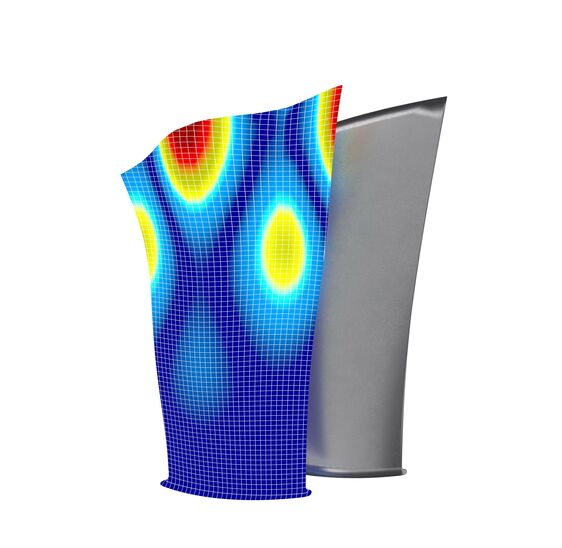Optomet’s Laser Doppler Vibrometers enable precise, non-contact measurement of turbine blade vibrations under varying load and temperature conditions. These measurements support the early detection of resonance issues and provide essential data on modal parameters, helping engineers to predict fatigue life and optimize maintenance cycles. By understanding the vibration characteristics, our technology ensures higher turbine efficiency, improved safety, and extended operational life in demanding aerospace environments.
Vibration Analysis for Turbines
Application of laser vibrometry on turbine blades

Turbine jet engines have become an indispensable part of aircraft in modern aviation. Further developments are always aimed at improving flight safety, turbine efficiency, overall operating behaviour and reducing noise emissions.
One of the most important components of the turbine jet engine is the single turbine blade. The characteristics of a turbine blade under different load levels and at different temperatures influences the overall engine behaviour.
One way to better estimate the fatigue life of a blade is the “low cycle fatigue” (LCF) measurement method, in which the turbine is examined before and after repeated cyclic loads. The fatigue due to thermal load is examined in more detail using “Thermomechanical Fatigue” (TMF) methods at temperatures of up to 1000°C. Model calculations of the blade geometry serve to optimize damping properties and flow behaviour, as well as to suppress unwanted resonances.
Optomet laser Doppler vibrometers offer a reliable way of precisely measuring the operating vibrations of the blades before, after and during loading and heating phases using a non-contact method. Knowledge of the vibration properties allows the determination of modal parameters and the validation of model predictions. The change in properties under different loading methods allows users to predict the expected lifetime of the turbine under real operating conditions. The results are therefore important for determining the maintenance cycles of turbines and estimating the possible lifetime of turbines under overload, for example if the remaining turbine has to be operated well above normal load to compensate for the failure of another aircraft engine.
Scanning laser vibrometer systems provide particular added value for this method, since they enable quick and easy characterization of the operating vibration shapes on the blade surface.
Due to high signal strength and signal quality of Optomet laser Doppler vibrometers, special treatment or preparation of measurement surfaces is no longer necessary. Vibration parameters can be measured precisely even on glowing and poorly reflecting objects.
Precise modal analysis of a turbine blisk with laser Doppler vibrometers
The SMART Scan+ from Optomet captures the vibrations of entire surfaces for fast and reliable modal analysis which is especially useful for example in the aerospace industry. This high-precision system enables the detailed investigation of the vibration characteristics of aircraft parts by accurately determining the modal parameters.
With the SMART Scan+, developers and engineers can quickly and accurately characterize vibration modes of components such as turbine blades. This plays a key role in evaluating and optimizing the structural integrity and durability of components.
Deflection Shapes of a Turbine Blade
Our Laser Doppler Vibrometer precisely and contactlessly analyzes the vibration patterns of individual turbine blades. These measurements provide valuable insights into the deflection shapes and vibration characteristics of the blades, contributing to structural optimization and extended lifespan. The technology allows for realistic load testing, enabling early detection of resonances and ensuring long-term operational safety.


 SMART Scan+
SMART Scan+
 SMART 3D-Scan
SMART 3D-Scan
 SMART Full Body
SMART Full Body
 SMART Single+
SMART Single+
 SMART Multi-Fiber
SMART Multi-Fiber
 SMART 3D-Fiber
SMART 3D-Fiber
 SMART DAQ
SMART DAQ
 Software SMART Lab
Software SMART Lab
 Scanning Vibrometer
Scanning Vibrometer
 Vector-Series
Vector-Series
 Vector-Micro-Optics
Vector-Micro-Optics
 Nova-Series
Nova-Series
 Nova-Xtra
Nova-Xtra
 Fiber-Series
Fiber-Series
 Fiber-Multiplex
Fiber-Multiplex
 Fiber Micro Manipulator
Fiber Micro Manipulator
 OptoSCAN
OptoSCAN
 OptoGUI
OptoGUI
 Single-Point Vibrometers
Single-Point Vibrometers
 Scanning Vibrometers
Scanning Vibrometers
 3D-Laser Vibrometers
3D-Laser Vibrometers
 Acoustics & Ultrasonics
Acoustics & Ultrasonics
 Aerospace and aviation
Aerospace and aviation
 Automotive
Automotive
 Biology & Medicine
Biology & Medicine
 Brake noise
Brake noise
 Civil Engineering
Civil Engineering
 Electronics & Household Devices
Electronics & Household Devices
 Materials Research
Materials Research
 Medical technology
Medical technology
 Tools & Machinery
Tools & Machinery
 Turbine
Turbine
 Wind tunnel testing
Wind tunnel testing


